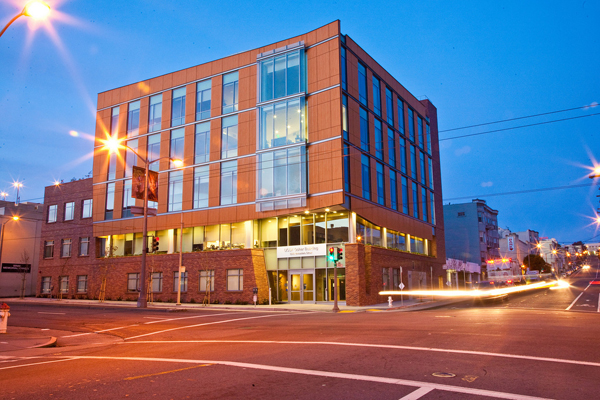Subscribe Now
UCSF Osher Center for Integrative Medicine Celebrates New Building
 UCSF’s center for integrative medicine has opened the doors of its new home at the UCSF Mount Zion campus. The UCSF Osher Center for Integrative Medicine offers the best of modern medicine with established healing practices from around the world, and is a major hub of research, education and patient care in integrative medicine.
UCSF’s center for integrative medicine has opened the doors of its new home at the UCSF Mount Zion campus. The UCSF Osher Center for Integrative Medicine offers the best of modern medicine with established healing practices from around the world, and is a major hub of research, education and patient care in integrative medicine.
The new Osher Building underscores UCSF’s commitment to increasing access to integrative medicine and making it a larger part of the treatment relationship between medical caregivers and patients. It is the first center of its kind to offer fully developed programs in research, clinical care and education for health care professionals, practitioners and patients seeking an integrated, healing-oriented approach to health.
Yoga and tai chi rooms and a meditative garden exist alongside relaxing, clinical exam rooms.
“At the Osher Center our goal is to enhance health and well-being, and research shows that the clinical environment can contribute to this,” said Margaret A. Chesney, PhD, the center’s director.
The five-floor, 48,000-square-foot building houses both the Osher Center for Integrative Medicine and the UCSF Division of General and Internal Medicine. The $37 million project was made possible through gifts from Bernard and Barbro Osher. The Center is the longtime vision of The Bernard Osher Foundation to advance the scientific and clinical understanding of complementary and integrative therapies to improve health care across the world.
“Our hope,” noted the Oshers, “is that the activities undertaken in this structure, enhanced by the Takahashi meditation garden, will promote good health and wellness, respect for the healing traditions of many cultures and individual progress toward more balanced and meaningful lives.”
The design, by KMD Architects, creates a healing environment inside and out. The interior features natural light, fresh air, and simply organized spaces. The building’s size and exterior, veneered in brick and wood resin materials, were designed to be responsive to the surrounding neighborhood, and the construction involved sustainable building practices that received LEED Silver certification from the United States Green Building Council.
The Center provides treatment, wellness and prevention programs for adults and children in areas including cancer, chronic pain and women’s health. Physicians and therapists are trained in general integrative medicine, integrative oncology, integrative psychiatry, Traditional Chinese Medicine, Ayurveda (a traditional healing science from India), mindfulness meditation, and manual therapies such as physical therapy and breath work.
The building includes spaces not usually found in conventional medical clinics or academic institutions, such as:
• Group rooms for yoga and tai chi instruction;
• Quiet areas for meditation and reflection;
• The Takahashi Japanese Meditative Garden, accented with Japanese maples;
• Treatment rooms for acupuncture, massage therapy, biofeedback and mind-body awareness;
• Air conditioning that uses 100 percent outside air; and
• Sustainable building materials like bamboo and recycled-content carpet.
The facility enables all of the Center’s programs and its 80 scientists, faculty and staff to be housed under one roof, with room to grow over time.
“Being in one location will facilitate communication among all of our experts, speeding the translation of research into practice for improved care to our patients,” Chesney said. “This is increasingly important as consumer and clinician interest continues to rise in integrative approaches to healing and healthy living practices.”
Approximately 38 percent of adults and more than 11 percent of children were using complementary medicine practices by 2007, according to the Centers for Disease Control and Prevention.Data show that use of natural products such as fish oil and techniques such as deep breathing, meditation, massage, and yoga are among the most common therapies.
“The integrative medicine approach is considered a partnership among practitioners, patients and families, and includes strategies tailored to each patient’s unique situation,” said Kevin A. Barrows, MD, director of Clinical Programs at the Osher Center. “With its progressive thinking and multicultural environment, Northern California has long been a pioneer in the practice and research of complementary healing approaches. The Bay Area is a perfect place to offer such services to patients.”
Construction began in April 2009, and was completed in October 2010. The project was managed by local developer SKS Investments.
“SKS Investments collaborated with an outstanding team on the Osher Building, in particular, individuals from the Osher Center and UCSF who were key to the project’s success,” said Dan Kingsley, managing partner at SKS Investments. “Our partner, KMD Architects, did an excellent job in creating a design that inspires warmth and humanity, incorporating natural elements and maximizing daylight making patients’, visitors’ and staffs’ well-being a number one priority.”
UCSF is a leading university dedicated to promoting health worldwide through advanced biomedical research, graduate-level education in the life sciences and health professions, and excellence in patient care. More information is available at www.ucsf.edu. Follow UCSF on Twitter at http://twitter.com/ucsf.
Tags:
Posted February 17, 2011
More Articles:
- Coverings 2024
Apr 22, 2024 – Apr 25, 2024 - Hospital, Outpatient Facilities & Medical Office Buildings Summit
Apr 25, 2024 – Apr 25, 2024 - CxA Workshop & Exam
Apr 29, 2024 – Apr 30, 2024 - EMP Seminar & Exam at CxEnergy 2024
Apr 29, 2024 – Apr 30, 2024 - CxEnergy
Apr 29, 2024 – May 2, 2024 - PHCC West 2024
Apr 29, 2024 – May 2, 2024 - Lean in Design Forum 2024
May 1, 2024 – May 2, 2024










